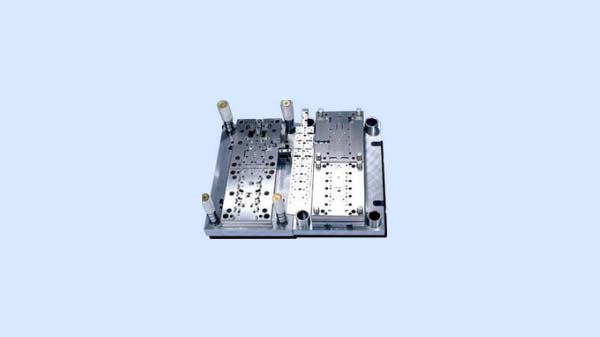The mold technology level is an important indicator to measure the manufacturing level of a country. With the further development of my country's industry, the mold industry is required to develop in a large-scale, accurate, effective and multi-functional direction. One of the important methods is to combine mold and automation. , This article discusses the development direction of stamping dies based on experience and automation technology in the field of cold stamping dies.
1. The development status of cold stamping dies
The key to the development of stamping die is die manufacturing technology, die materials and die talents. The development of mold technology is a key factor in the development of the mold industry. Its development goal is to meet the requirements of short delivery time, high precision, good quality and low price of mold products. One of the important directions is to vigorously develop mold automation. The related automation development of stamping molds is to combine traditional molds with optomechanical technology, integrate multi-process automation modules into the molds, and realize complete continuous mold production through electrical control, thereby saving a lot of machinery and manpower, and greatly The efficiency is improved to the limit. Optimize process and maximize revenue
Second, the advantages of stamping automated production
Pressing processing refers to the process of installing a die on a press machine and passing a plate-shaped material between the dies. The punching force deforms, cuts, bends and shapes the material. Stamping processes that can be automated include: hardware riveting, tapping, self-riveting and mutual riveting, and integrated production of small parts.
The stamping process is widely used in the market for parts with thin walls, light weight, good rigidity, high surface quality and complex shapes. These parts are difficult to manufacture by other processing methods due to their good interchangeability and material saving. The production of stamping dies is done manually, which greatly limits its development.
The problems with manual stamping are:
1. Stamping is a heavy physical operation, which is dangerous, making it difficult for stamping companies to recruit workers;
2. Manual stamping requires a large working space, a large inventory of semi-finished products, and the failure to introduce new stamping and die technology in time, resulting in low actual production efficiency and high cost;
3. Due to equipment failure or human factors, manual stamping will cause safety injuries. The stamping automation production line mainly makes up for the above shortcomings. With the advent of the era of a small number of electronic products and the influence of factors such as difficulty in recruiting and expensive labor, cold stamping, the development of field automation is an inevitable requirement.
3. Examples of stamping automation production technology development
1. In-mold rivet technology
(1) Traditional rivet technology: using continuous blanking, manually put the rivet into the product, and then riveting by the work station. This production method requires more machines and manpower, is labor intensive and low in efficiency.
(2) Innovative in-mold rivet technology: This technology uses a vibrating plate to directly vibrate, so that the studs are arranged in an orderly manner and enter the front end of the shunt rod. The upper die inserts the knife to drive the separating rod to guide the 1PCS stud at a time. The material is transported to the riveting point inside the mold through the guide rail under the action of air, and then enters the riveting state. When riveting, the clamping slider first clamps the stud and accurately positions the stud. During the downward processing of the mold, the floating rivet punch moves downward, and the fork knife drives the side slider to move to both sides, and the clamping slider is separated. After the floating riveting punch is in place, the upper die continues to descend, and the riveting punch drives the stud to complete the riveting, realizing a complete continuous mold production.

2. In-mold servo tapping technology
(1) Traditional tapping technology: using continuous punching die, the product is manually put into the desktop tapping machine for tapping. This production method requires more machines and manpower, is labor intensive and low in efficiency.
(2) Innovative servo in-mold tapping technology: This technology is driven by a servo motor, a high-precision gear transmission, and a universal joint connects the gear shaft and the rack shaft. The lower mold adopts a movable demolding structure, and the upper mold moves down before pressing the material before tapping. The tooth rod is designed with a quick-change clamping mechanism to quickly change the tap. The entire tapping module has a compact structure and can be fully integrated in the lower mold, so that it can be disassembled and maintained quickly and easily. The universal joint structure, the position of the tap shaft can be adjusted at will, with strong versatility. Synchronous tapping in the mold can reach 20 PCS, and the production capacity can reach 2000 PCS/hour, realizing complete continuous mold production.
3. Integrated technology of in-mold riveting
(1) Traditional riveting technology: using continuous blanking, manual rivet riveting at the work station, and then manual gluing. This production method requires more machines and manpower, is labor intensive and low in efficiency.
(2) Innovative in-mold rivet and glue application integration technology: This technology first integrates the in-mold rivet module into the continuous mold. The glue application module includes a feeding mechanism, a peeling mechanism, a combining mechanism and a receiving mechanism. Material mechanism, electrical control. The entire module can be disassembled quickly and independently, making it easy to maintain. The feeding mechanism is located at the front end of the mold to facilitate the replacement of the material roller. Power supply adopts servo control, stable and reliable operation. The laminating mechanism is designed with one mold and three holes to match the mold capacity, to achieve full continuous production, and the capacity can reach 1800 PCS/hour.
4. Multi-material belt riveting technology
(1) Traditional multi-product mutual riveting technology: multi-product mutual riveting usually uses several sets of molds to produce a single product, and then manually assemble the products, and use the station mold for riveting. This production method requires more machines and manpower, is labor intensive and low in efficiency.
(2) Innovative multi-material belt riveting technology: This technology integrates multiple products into a set of molds. According to the product riveting method, parallel feed and vertical feed are designed respectively. Parallel feeding is completed by the feeder of the punch press, and vertical feeding is completed by two sets of micro pneumatic feeding mechanisms. The feeding mechanism 1 pulls the material at the front end, and the feeding mechanism 2 realizes accurate feeding. The products to be riveted are sent to the riveting position through the material belt or conveying mechanism, the upper die is riveted down, and then the material is cut and discharged. This technology realizes the production of multi-product full continuous molds, and the production capacity can reach 2000 PCS/hour.
After years of practical exploration, stamping automation production has achieved gratifying results. The introduction of production has brought considerable economic benefits. Industry is the foundation of a country and the foundation of a strong country. As the mother of industry, molds are very important. At present, the country is vigorously implementing the road to promote the upgrading and development of the manufacturing industry, and the transformation of molds to automation is the only way. Wearing the wings of wisdom on the mold will greatly enhance the core competitiveness of enterprises in the industry.

Scan mobile station
Jinan Ruifu Mechanical Engineering Co., Ltd.
 Address: No. 686, Songzhuang Industrial Park, Huaiyin Section Store, Jinan City, Shandong Province
Address: No. 686, Songzhuang Industrial Park, Huaiyin Section Store, Jinan City, Shandong Province
 Phone: 0531-87512892/87518718
Phone: 0531-87512892/87518718
 Email: tong1203@163.com
Email: tong1203@163.com